- Books Name
- A TEXT OF BIOLOGY - CLASS XII
- Publication
- ACME SMART PUBLICATION
- Course
- CBSE Class 12
- Subject
- Biology
ONE GENE INTERACTION (w.r.t. Post-Mendelian inheritance)
(1) Incomplete dominance:
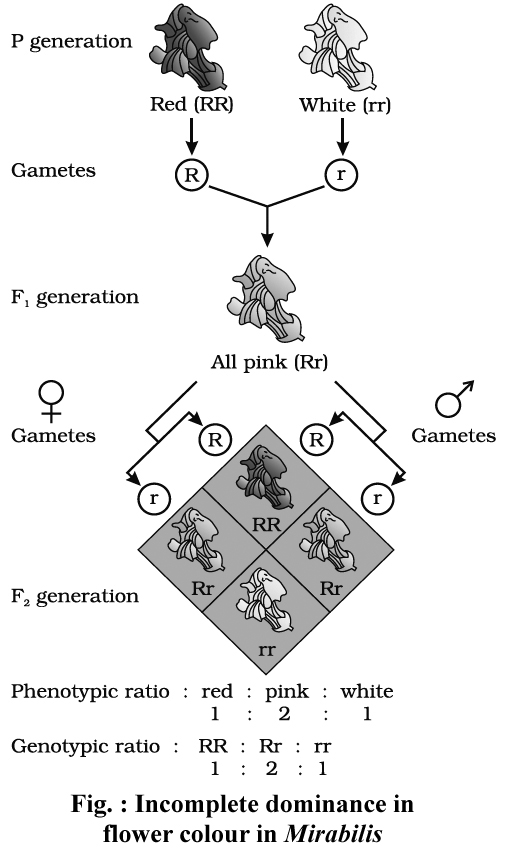
After Mendelism a few cases were observed where F1 phenotype is intermediate between dominant and recessive phenotypes.
The most common example of incomplete dominance is that of flower colour in Mirabilis jalapa (Gulbansi or 4'O clock plant), studied by Carl Correns.
Homozygous red (RR) flowered variety was crossed with white (rr) flowered variety.
F1 offspring had pink flowers.
Thus, here one allele is incompletely dominant over the other so that intermediate phenotype is produced by F1 hybrid with respect to the parents.
This is called incomplete dominance.
Incomplete dominance for flower colour [Red(RR), Pink(Rr), White (rr)] is also known to occur in Antirrhinum majus (Snapdragon or Dog flower).
The phenotypic ratio and genotypic ratio in F2 generation is identical in case of incomplete dominance i.e., 1 : 2 : 1.
Explanation of the concept of dominance:
Every gene contains information to express a particular trait.
Diploid organisms have two copies of each gene, they are called alleles.
These two alleles may be identical or non-identical.
One of them may be different due to some changes that it has undergone which modifies the information that particular allele contains.
Theoretically, the modified allele could be responsible for production of
(i) The normal/less efficient enzyme, or
(ii) a non-functional enzyme, or
(iii) no enzyme at all
In case (i), the modified allele is equivalent to the unmodified allele, i.e., it will produce the same phenotype/trait.
But, if the allele produces a non-functional enzyme or no enzyme [case (ii) &(iii)], the phenotype may be effected.
The unmodified (functioning) allele, which represents the original phenotype is the dominant allele and the modified allele is generally the recessive allele.
Hence, the recessive trait is due to nonfunctional enzyme or because no enzyme is produced.
If the mutated allele forms an altered but functional product, it behaves as incompletely or codominant allele.
(2) Multiple allelism:
Mendel proposed that each gene has two contrasting forms, i.e., alleles.
But there are some genes which are having more than two alternative forms (allele).
Presence of more than two alleles for a gene is known as multiple allelism.
Multiple alleles are present on the same locus of homologous chromosome.
Multiple alleles can be detected only in a population.
A well known example to explain multiple alleles in human beings is ABO blood type.
Landsteiner discovered ABO system of blood groups. The fourth group AB was discovered by de Castello and Steini.
Bernstein showed that these groups are controlled by 3 alleles -IA, IB and IO/i.
These alleles are autosomal and follow Mendelian pattern of inheritance.
The alleles IA and IB produce a slightly different form of the sugar while IO doesn't produce any sugar. Because humans are diploid organism, each person possesses any two of the three I gene alleles.
IA and IB are completely dominant over IO, but when IA and IB are present together they both express their own types of sugar thus, behaving as codominant alleles.
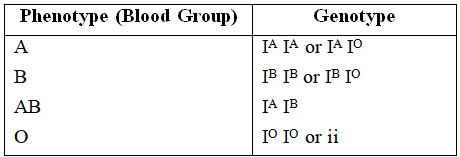
Possible blood types of children from parents of various blood types.
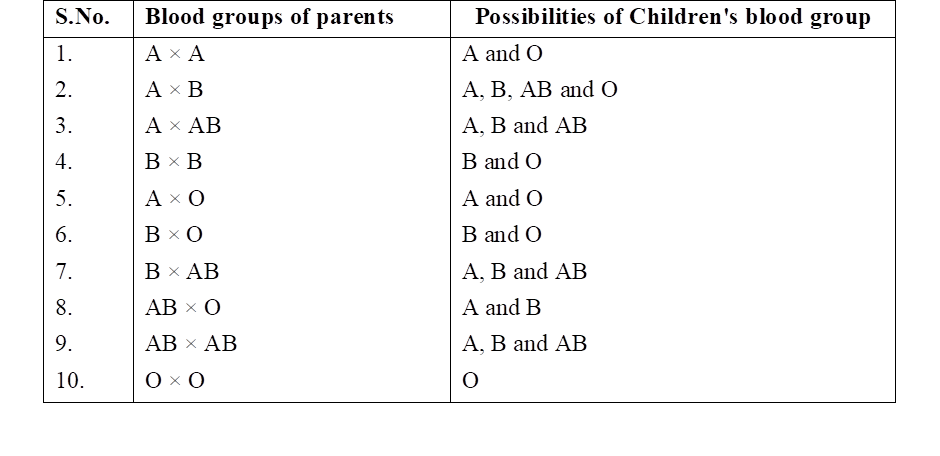
Other examples of multiple alleles are - coat colour in rabbit, eye colour in Drosophila and self incompatibility in tobacco. Formula to find out number of genotypes for multiple allelism is n/2(n +1) , where 'n' is number of alleles.
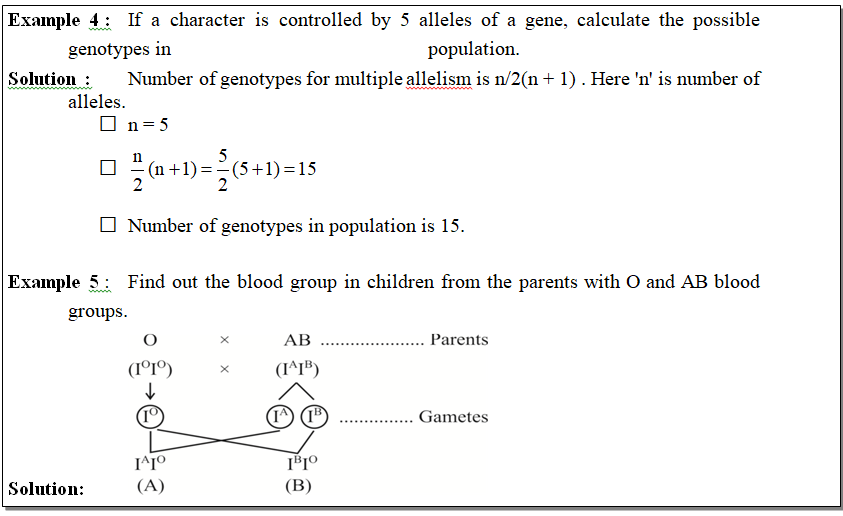
The possibility of blood groups in offsprings of this couple is A and B.
(3) Co-dominance.
In co-dominance, the genes of an allelomorphic pair are not related as dominant and recessive but both of them express themselves equally in F1 hybrids.
These follow the law of segregation and F2 progeny exhibits 1 : 2 : 1 ratio. Heterozygous for sickle cell anaemia (HbAHbS), AB and MN blood groups are examples of co-dominance of alleles.
(4) Lethal genes or lethality.
A lethal gene usually results in the death of an individual when present in homozygous condition. Most striking example to explain lethal gene is sickle cell anaemia (HbSHbS).
Cuenot (1905) first reported that inheritance in mouse body colour did not agree with Mendelian inheritance, because the dominant allele for yellow body colour is lethal in homozygous condition.
The homozygous dominant gene carrying mouse died, proving dominant gene is lethal in homozygous form.
This is called absolute lethality. In plants, it was first reported in Antirrhinum majus by E. Baur, where yellow leaved or golden leaved or Aurea plant never breed true. Thus, the ratio comes out to be 2 : 1.
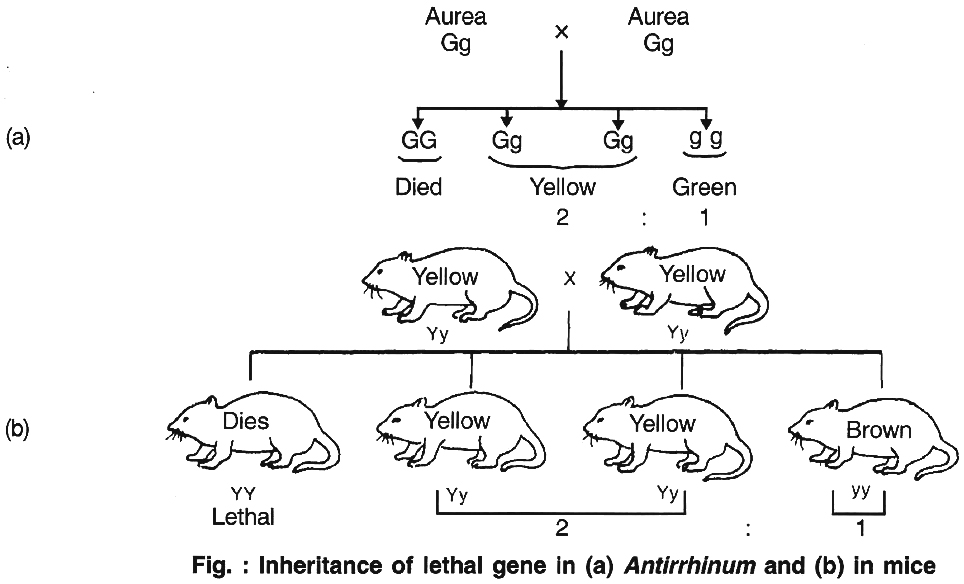
(5) Pleiotropic genes:
The ability of a gene to have multiple phenotypic effects (as it influences a number of characters simultaneously) is known as pleiotropy.
The gene having multiple phenotypic effects is called pleiotropic gene.
It is not essential that the traits are equally influenced. Sometimes, the effect of the gene is more evident in case of one trait (major effect) and less evident in case of others (secondary effect).
Occasionally, a number of related changes are caused by a gene.
They are together called syndrome.
Some common examples in humans are -Cystic fibrosis, Marfan syndrome and Phenylketonuria, while in Drosophila, a single gene influences the size of wings, character of balancers, position of dorsal bristles, eye colour, shape of spermathecae, fertility and longevity.
In human beings pleiotropy is exhibited by sickle cell anaemia in heterozygous condition (HbAHbS).
In case of pea, the gene which controls the starch synthesis also controls the shape of the seed.

Concept Builder
(1) Rh factor: It is an antigen protein on RBC surface, reported by Landsteiner and Wiener in blood of Indian brown Rhesus monkey (Macacus rhesus). 93% Indians have this antigen and are called Rh positive (Rh+).
(2) Marian syndrome: Slender body, elongation of limbs, hypermobility of joints, dislocation of lens and susceptibility to heart diseases.

 ACME SMART PUBLICATION
ACME SMART PUBLICATION
